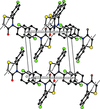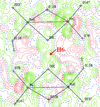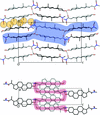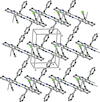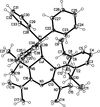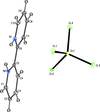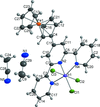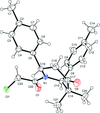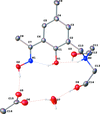issue contents
March 2015 issue

Cover illustration: The reaction of bis-(anthracene)cobaltate(-I) with excess cycloheptatriene resulted in a new 18-electron cobaltate containing two different seven-membered ring ligands. The asymmetric unit contains two independent cation-anion pairs of the title complex, [K(18-crown-6)][Co(![[eta]](/logos/entities/eta_rmgif.gif) 3-C7H7)(
3-C7H7)(![[eta]](/logos/entities/eta_rmgif.gif) 5-C7H9)], where 18-crown-6 is 1,4,7,10,13,16-hexaoxacyclooctadecane. This compound is of interest as the first to possess cycloheptatrienyl and cycloheptadienyl ligands in an anionic metal complex. See: Brennessel & Ellis [Acta Cryst. (2015). E71, 291-295].
5-C7H9)], where 18-crown-6 is 1,4,7,10,13,16-hexaoxacyclooctadecane. This compound is of interest as the first to possess cycloheptatrienyl and cycloheptadienyl ligands in an anionic metal complex. See: Brennessel & Ellis [Acta Cryst. (2015). E71, 291-295].
research communications
Download citation


Download citation


The title compound, [Rh(η5-C5Me5)Cl(C13H12ClN3)]Cl, is chiral at the metal and crystallizes as a racemate. Upon coordination, the hydrazinylidenepyridine ligand is non-planar, an angle of 54.42 (7)° being observed between the pyridine ring and the aromatic ring of the [2-(4-chlorophenyl)hydrazin-1-ylidene]ethyl group.
CCDC reference: 1045840
Download citation


Download citation


Single crystals of the langbeinite-related phosphate Rb0.743K0.845Co0.293Ti1.707(PO4)3 have been prepared by crystallization of high-temperature self-flux K2O–Rb2O–P2O5–TiO2–CoO.
CCDC reference: 1045876
Download citation


Download citation


The crystal structure of ALLN, the tripeptidic inhibitor of proteasomes, is solved from synchrotron diffraction data. An infinite β-sheet extended through the crystal is formed by symmetry-related oligopeptide molecules in extended conformation.
CCDC reference: 1046561
Download citation


Download citation


The crystal structure of the title compound displays a twist conformation of the imidazolidine ring with two (2-hydroxynaphthalen-1-yl)methyl substituents stabilized by two intramolecular O—H⋯N hydrogen bonds.
CCDC reference: 1046536
Download citation


Download citation


The title compound is non-planar, with the mean plane of the pyrene ring system and the terminal N-phenyl ring being inclined to the central p-phenylenediamine ring by 29.34 (4) and 43.43 (7)°, respectively. In the crystal, molecules are linked by a number of weak N—H⋯π, C—H⋯π and π–π interactions [inter-centroid distances = 3.5569 (11)–3.708 (1) Å], forming slabs lying parallel to (30 ).
).
CCDC reference: 1045835
Download citation


Download citation


In the related title compounds, (1) and (2), the 3-thiazolidine ring pucker is twisted on the S—Cmethine bond in (1), while in (2), the ring has an envelope conformation with the S atom as the flap. In the crystal of (1), molecules are linked by C—H⋯O hydrogen bonds forming chains along [100], while in the crystal of (2), molecules are linked by C—H⋯O and C—H⋯Cl hydrogen bonds forming slabs parallel to (001).
Download citation


Download citation


Crystal structure of heptaguanidinium nonahydrogen bis[α-hexamolybdoplatinate(IV)] heptahydrate
A compound, (CH6N3)7H9[PtMo6O24]2·7H2O, containing the well-known Anderson-structure heteropolyoxomolybdate, was obtained by recrystallization of its powdered guanidinium salt. The protonated O atoms in the polyanion were confirmed by electron-density maps, interpolyanion hydrogen bonds and bond-valance sums (BVS).
CCDC reference: 1048266
Download citation


Download citation


Crystal structure and luminescent properties of [1-(biphenyl-4-yl)-1H-imidazole-κN3]dichloridozinc
A new imidazole-based zinc complex, synthesized using hydrothermal methods, exhibits luminescent behaviour.
CCDC reference: 1048515
Download citation


Download citation


In research towards new antagonists against the Liver X receptor, the important intermediate Fernholz acid Weinreb amide has been synthesized and characterized.
CCDC reference: 1045692
Download citation


Download citation


The mixed-metal thiophosphate Nb1.18V0.82PS10 has been prepared by the use of a halide flux and the crystal structure has been analyzed by single-crystal diffraction methods.
CCDC reference: 1049300
Download citation


Download citation


In the title compound, the deprotonated guanine molecules are arranged in centrosymmetric pairs, and form hydrogen bonds with the neighboring water molecules.
CCDC reference: 1049453
Download citation


Download citation


1-(2-Hydroxyethyl)-2-methyl-5-nitro-1H-imidazole (metronidazole, MET) reacts with AgBF4 to give [Ag(MET)2]BF4, in which the Ag atom is coordinated by two MET ligands with a trans arrangement.
CCDC reference: 1048516
Download citation


Download citation


The CrIII ion in the title complex is coordinated by two 1,10-phenanthroline (phen) ligands, one water molecule and a chloride in a cis geometry, displaying a distorted octahedral environment. The [ZnCl4]2− anion has a slightly distorted tetrahedral coordination geometry.
CCDC reference: 1049598
Download citation


Download citation


The reaction of bis(anthracene)cobaltate(−I) with excess cycloheptatriene, C7H8, resulted in a new 18-electron cobaltate containing two different seven-membered ring ligands, based on single-crystal X-ray diffraction. This compound is of interest as the first to possess cycloheptatrienyl and cycloheptadienyl ligands in an anionic metal complex.
CCDC reference: 1049452
Download citation


Download citation


The packing of the title compound features N—H⋯N hydrogen bonds, which form inversion dimers, and weak aromatic π–π stacking interactions.
CCDC reference: 1048517
Download citation


Download citation


A new silver aluminium trimanganese pentamolybdate, AgMnII3(MnIII0,26Al0,74)(MoO4)5, is composed of M2O10 dimers, M3O14 (M = Mn, Al) trimers and MoO4 tetrahedra sharing corners and forming three types of layers. A comparative structural description is provided with the structures of related phases containing dimers, trimers and tetramers.
Download citation


Download citation


The title compounds, (I) and (II), are hydrazinecarbothioamide derivatives. In the crystal of (I), two independent molecules are linked by bifurcated N—H⋯O and C—H⋯O hydrogen bonds, forming two  (6) ring motifs, and
(6) ring motifs, and  (10) and
(10) and  (14) ring motifs. In the crystal of (II), molecules are linked by pairs of N—H⋯S hydrogen bonds, forming inversion dimers with an
(14) ring motifs. In the crystal of (II), molecules are linked by pairs of N—H⋯S hydrogen bonds, forming inversion dimers with an  (8) ring motif.
(8) ring motif.
Download citation


Download citation


The hemi-diethyl etherate of the square pyramidal copper complex, 1-butene-bis(pyridin-2-ylmethyl)amine copper(II) chloride is reported. The basal plane consists of the three nitrogen atoms from the ligand and one chlorine. The second chlorine occupies the apical position of the square pyramid.
CCDC reference: 1050406
Download citation


Download citation


In the title compound, the imidizadoline ring adopts an envelope conformation and the nitrogen lone pairs are oriented in a syn disposition. The crystal packing is stabilized by C—H⋯O hydrogen-bonding interactions.
CCDC reference: 1046907
Download citation


Download citation


In the title compound, C15H15N3OS, intramolecular N—H⋯O and C—H⋯S hydrogen bonds both generate S(6) rings. The C=O and C=S bonds lie to opposite sides of the molecule. In the crystal, inversion dimers linked by pairs of N—H⋯S hydrogen bonds generate  (8) loops.
(8) loops.
CCDC reference: 1050132
Download citation


Download citation


The title compound was synthesized using solid-state reaction and characterized by X-ray diffraction. The structure crystallizes in an own structure type which is a commensurate superstructure of an underlying B8-type substructure.
CCDC reference: 1050846
Download citation


Download citation


The title complex, [Mg(C7H7N4O2)2(H2O)4], lies across an inversion centre and the MgII atom is coordinated in a slightly distorted octahedral environment by four aqua ligands in the equatorial sites and imidazole ring N atoms in the axial sites. In the crystal, O—H⋯O and O—H⋯N hydrogen bonds link complex molecules, forming a three-dimensional network incorporating  (8) and
(8) and  (18) graph-set motifs.
(18) graph-set motifs.
CCDC reference: 1050901
Download citation


Download citation


The dinuclear title compound crystallizes as a dimer forming a tetranuclear copper(II) complex, [Cu4(CH3O)4(C11H13O2)4], in the solid state. In this complex, all CuII atoms have a square-pyramidal coordination sphere, with long axial and short basal Cu—O distances.
CCDC reference: 1050914
Download citation


Download citation


The first crystal structure determination of 1-bromo-2-(phenylselenyl)benzene is presented. The molecules form weak dimers through displaced parallel π-stacking interactions.
CCDC reference: 1050354
data reports
inorganic compounds
Download citation


Download citation


metal-organic compounds
Download citation


Download citation


Download citation


Download citation


Download citation


Download citation


Download citation


Download citation


Download citation


Download citation


Download citation


Download citation


Download citation


Download citation


Download citation


Download citation


Download citation


Download citation


Download citation


Download citation


Download citation


Download citation


Download citation


Download citation


Download citation


Download citation


organic compounds
Download citation


Download citation


Download citation


Download citation


Download citation


Download citation


Download citation


Download citation


Download citation


Download citation


Download citation


Download citation


Download citation


Download citation


Download citation


Download citation


Download citation


Download citation


Download citation


Download citation


Download citation


Download citation


Download citation


Download citation


Download citation


Download citation


Download citation


Download citation


Download citation


Download citation


Download citation


Download citation


Download citation


Download citation


Download citation


Download citation


Download citation


Download citation


Download citation


Download citation


Download citation


Download citation


Download citation


Download citation


Download citation


Download citation


Download citation


Download citation


Download citation


Download citation


Download citation


Download citation


Download citation


Download citation


Download citation


Download citation


Download citation


Download citation


Download citation


Download citation


Download citation


Download citation


Download citation


Download citation


Download citation


Download citation


Download citation


Download citation


Download citation


Download citation


Download citation


Download citation


Download citation


Download citation


Download citation


Download citation


Download citation


Download citation


Download citation


Download citation


Download citation


Download citation




 journal menu
journal menu
















